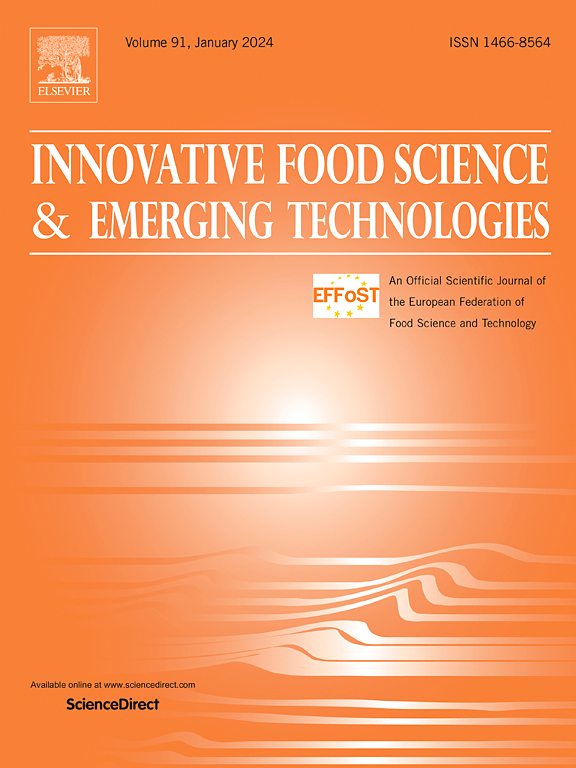Modified gluten by extrusion can significantly improve the amounts of flavor compounds during the fermentation of umami condiment
IF 6.3
1区 农林科学
Q1 FOOD SCIENCE & TECHNOLOGY
Innovative Food Science & Emerging Technologies
Pub Date : 2024-12-26
DOI:10.1016/j.ifset.2024.103907
引用次数: 0
Abstract
Gluten is widely used in food process, but rarely used in the fermentation of umami condiment. The extrusion treatment could modify the microstructure of gluten, which may further influence fermentation effectiveness. This study applied gluten and modified gluten obtained by extrusion as raw materials to koji and moromi fermentations. During the koji fermentation, water and Aspergillus oryzae applied to modified gluten penetrated into the inner layer of raw material more efficiently when compared with their application to gluten. After the fermentation, the amino acid nitrogen contents of prepared four group samples ranged from 0.80 g/100 mL to 1.05 g/100 mL, while the contents of glutamic acid, adenosine monophosphate (AMP), guanosine monophosphate (GMP), acetic acid and lactic acid etc. had significant increases, indicating the utilization of gluten in fermentation could produce large amounts of flavor compounds. Additionally, the modification of gluten accelerated the fermentation of A. oryzae and improved the utilization and efficiency of fermentation raw materials, while the soybean protein isolate could partially replace gluten to produce high amounts of flavor compounds during the fermentation. This study broadened the utilization scope of gluten in food industry and provided a reference for the fermentation of umami condiment.
挤压改性面筋可显著提高鲜味调味品发酵过程中风味化合物的含量
面筋在食品加工中应用广泛,但鲜味调味品发酵中应用较少。挤压处理可以改变面筋的微观结构,进而影响发酵效果。本研究将挤压法制得的面筋和改性面筋作为原料,应用于曲和森米的发酵。在曲发酵过程中,用于改性面筋的水和米曲霉比用于面筋的水和米曲霉更有效地渗透到原料内层。发酵后,制备的4组样品氨基酸氮含量在0.80 g/100 mL ~ 1.05 g/100 mL之间,谷氨酸、单磷酸腺苷(AMP)、单磷酸鸟苷(GMP)、乙酸和乳酸等含量显著增加,说明面筋在发酵过程中的利用可以产生大量的风味化合物。此外,麸质改性加速了A. oryzae的发酵,提高了发酵原料的利用率和效率,而大豆分离蛋白可以部分替代麸质,在发酵过程中产生大量的风味化合物。本研究拓宽了面筋在食品工业中的应用范围,为鲜味调味品的发酵提供了参考。
本文章由计算机程序翻译,如有差异,请以英文原文为准。
求助全文
约1分钟内获得全文
求助全文
来源期刊
CiteScore
12.00
自引率
6.10%
发文量
259
审稿时长
25 days
期刊介绍:
Innovative Food Science and Emerging Technologies (IFSET) aims to provide the highest quality original contributions and few, mainly upon invitation, reviews on and highly innovative developments in food science and emerging food process technologies. The significance of the results either for the science community or for industrial R&D groups must be specified. Papers submitted must be of highest scientific quality and only those advancing current scientific knowledge and understanding or with technical relevance will be considered.

 求助内容:
求助内容: 应助结果提醒方式:
应助结果提醒方式:


